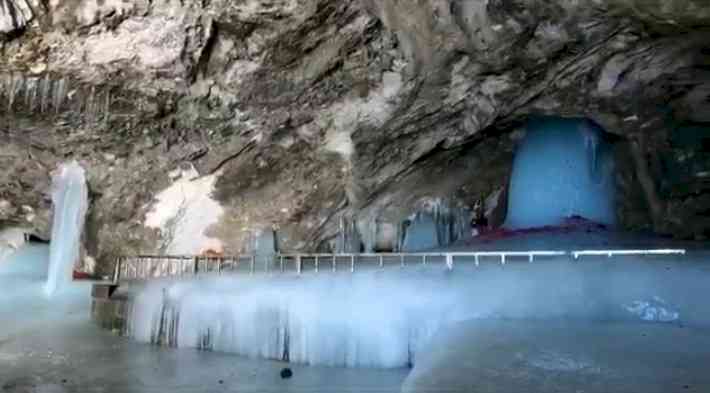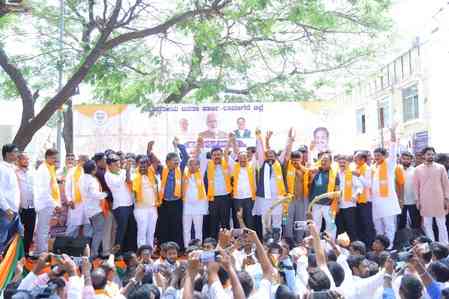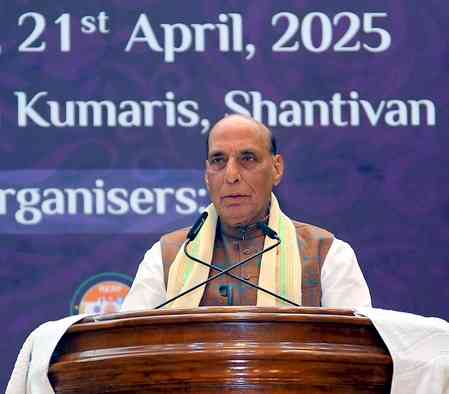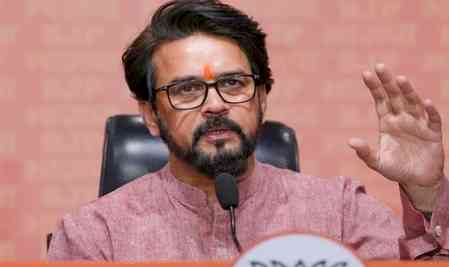This year's Amarnath Yatra will be a blockbuster event
After two years of postponement, the Amarnathji Yatra is expected to be the party of the year in the lap of the Himalayas.

Srinagar, April 28 (IANS) After two years of postponement, the Amarnathji Yatra is expected to be the party of the year in the lap of the Himalayas.
The Jammu and Kashmir administration is anticipating six to eight lakh pilgrims, who will trek through the Himalayas in south Kashmir to catch a glimpse of the momentary stay of Lord Shiva in the form of an ice Lingam.
J&K Lieutenant Governor Manoj Sinha is personally supervising all the Yatra arrangements.
The pilgrimage will begin on June 30 and continue for 43 days till August 11, the day of Raksha Bandhan, as per tradition.
This year it will be a historic pilgrimage with top-notch facilities in place -- safe drinking water, lodging, sanitation, skywalks, spiritual theme parks -- and the administration is ready for all challenges.
Jammu and Kashmir has undergone an unprecedented transformation in just the last 1.5 years. With the help of the leadership at the Centre and the enterprising youth of the state, JKUT has signed investment proposals worth Rs 52,088 crore in one year.
In the past six months, 80 lakh tourists visited the Valley, a number that suggests people have started feeling secure and welcome in the Union Territory. Rather than "negotiating" for peace, the UT administration has uprooted the very eco-system of terrorism.
This historic Yatra is the best representation of the composite culture of Kashmir that extremists do not want to popularise in the media. Every year the pilgrimage is welcomed with open arms in the Valley and the Kashmiris have always had their doors and hearts open towards the travellers. Their generosity and hospitability are well-known.
With a five-tier security cover in place, recently upgraded roads, 75 new tourist destinations, and renovation of religious and historic structures in Kashmir, the UT administration is hoping to retain at least half of the Yatris for an extra 3-4 days' stay in the Valley.
The pilgrimage will give people across the nation a chance to experience heaven in its best phase in three decades. The Naya Kashmir has much to offer and an organic narrative from the Yatris will help spread the word to the rest of the country.
Many new Yatri Niwas are being raised -- some temporary arrangements and some with hotel infrastructure. Environmental welfare is also a major priority of the administration this year, so cleanliness and waste disposal will take the front seat.
To publicise the Yatra to a larger audience across India, the UT administration is distributing short films showcasing the journey to Shiva-Parvati's abode paired with a heavenly, fulfilling holiday in Kashmir, the land of saints and peers.
This year the pilgrim vehicles will have RFID-based (Radio Frequency Identification) tracking and surveillance which will note each person's movement on the route.
During registration, all pilgrims will receive a wristband fitted with microchips connected to satellite towers. This is the first time that pilgrims will be on such close watch; the government wants to rubbish the rumours about the Yatra being unsafe and dangerous.
The registration for the Yatra began two weeks back at the designated 566 bank branches across the districts and on the online website of the Shri Amarnathji Shrine Board (SASB).
The journey will take two courses - the traditional 48-km from Nunwan to the cave shrine from Pahalgam in south Kashmir's Anantnag, and the more challenging 14-km Baltal route in the Ganderbal district in central Kashmir.
Eight base hospitals have been set up on the Baltal route and 20 on the Pahalgam route, along with medical camps on the way. The insurance cover has been increased from Rs 3 lakh to Rs 5 lakh. The Shrine Board will also provide free-of-cost battery car service for pilgrims on the 2.75 km-long Baltal-Domel stretch.
The National Disaster Response Force (NDRS) and the State Disaster Response Force (SDRF) are undergoing specialised training to be a part of the Mountain Rescue Teams (MRTs) of JK Police. They will be deployed at a few difficult terrains on the Yatra routes.
CRPF companies will be deployed to ensure incident-free pilgrimage. Other companies will include BSF, ITBP, Sahastra Seema Bal (SSB), CISF, and of course the Indian Army.
Media units will be set up along the tracks to deliver advisories to the tourists and motivate them to complete the journey with a sense of security by amplifying the success stories of the UT administration in terms of development works.
The J&K Director General of Police has reviewed additional security measures being taken along the Jammu-Srinagar National Highway. He has taken stock of all Yatri Niwas stays and transit camps enroute the National Highway.
Checkpoint functioning has been enhanced and traffic control has been given special impetus so it does not interfere with general public's convenience. The newly-built Navyug Tunnel connecting Banihal in Jammu with Qazigund in south Kashmir is under review for security measures.
On Wednesday, the UT administration re-constituted 21 tourism development authorities keeping in view the Yatra and tourist footfalls during the summer season.
Valley dwellers have converted their homes into homestays with the help of the Indian Army to boost tourism and economy. In the wake of spiritual tourism in the country, the Department of Tourism has started organising cultural events during major festivals. With the surrection of the Pracheen Pandava Gufa, Parshuram Temple, Raghunath Temple, Sheetal Nath Temple, Ziyarat of Hazrat Sheikh Dawood etc., the administration is hopeful to attract tourists and increase Indians' confidence in the Valley.


 IANS
IANS 










